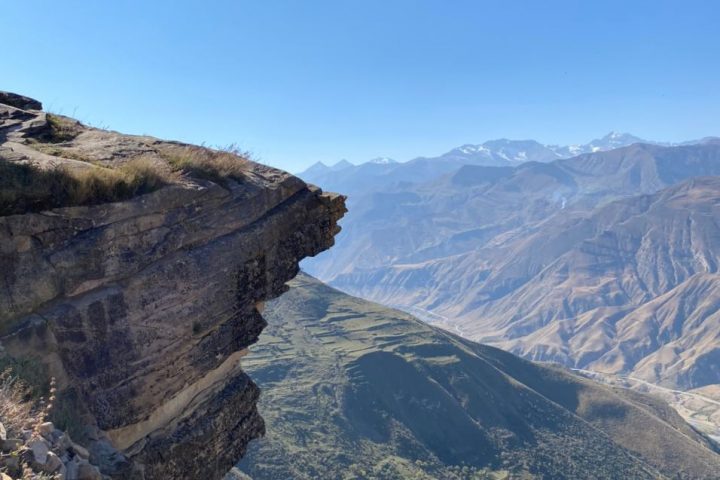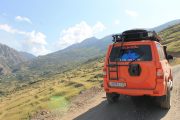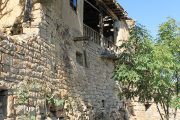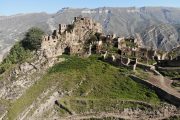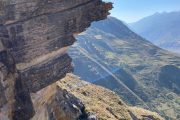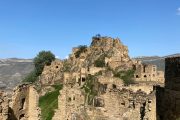We leave Nalchik at 6 am. We have a way through four republics.
The journey till Dagestan takes approximately 5.5 hours.
The trip is possible only for ACTIVE PEOPLE who easily endure the road.
The program includes a visit to:
Old Karadakh
Old Goor
Old Cahib
Aul Chokh
Aul Gost Gamsutl
Mountainous Dagestan is an amazing place, a country of mountains and languages. Such beautiful places worth seeing.
Having swept through the entire mountainous Dagestan, we fell in love with this republic, where landscapes changed every half a meter. We think everyone should see this. We have laid out the most convenient and interesting routes for you.
Day one
Karadakh Gorge
Karadakh is a village in the Gunibsky district of Dagestan. It is part of the rural settlement Selsoviet Korodinsky.
We will immediately go along our route, namely to the Karadakh gorge, one of the most beautiful and popular places in mountainous Dagestan.
We warn you that it is always windy and cool there.
For many years, the waters of the Kvartakh River eroded the limestone rock, and the seemingly impregnable rocks could not withstand this force. Gradually, the water cut through the stone, and as a result, a picturesque gorge was formed, which is called the Karadakh gorge. Now, between the rocky ledges, there is a channel of a mountain river, it looks tiny and it is hard to imagine that its waters could erode the limestone rock in such a way.
However, after heavy rain, the water level can rise by 3-4 meters, and the force of the stream becomes crushing — it picks up huge stones and pushes them. Then the water recedes, the boulders remain where the river left them, but the power of the water flow must be remembered when planning a trip to the gorge — if heavy rain is expected, it is safer to postpone your acquaintance with the unique natural corridor.
The attraction is a gorge with a length of almost half a kilometer and a maximum width of 5 m, stone walls up to 170 m high rise on both sides. While walking between these huge rocks, it can become a little uncomfortable — it seems that the mountains are about to close. In some areas, the rocks really form stone vaults, sometimes boulders are visible between the walls — they flew down the cliff, but got stuck along the way.
Old Goor
Thus, with stops, we will reach the Shamil region and climb up the mountain to the village of Goor, where the ruins of the Goor towers and the famous Troll’s Tongue will be waiting for us. The bravest of you will be able to stand on the edge of the Tongue and feel like the Lord of the mountains. But it’s quite life-threatening and we don’t recommend getting close to the cliff! A walk through the ruins of the Goor towers will take you back to ancient times, where many pictures of that time come to your imagination.
Old Goor is one of the attractions of Dagestan. Once it was an impregnable defensive complex of seven towers and residential buildings, located on the top of a mountain, on the edge of a steep abyss. Four towers, including the largest one, 25 meters high, are now destroyed. From their remains, the Highlanders built buildings in the new part of the village, where they began to move in the middle of the 20th century in search of an easier life. The Goor towers have an interesting feature: some leaned at a slight angle, tapering upwards. This made it possible to defend more effectively: during the siege of the village, stones were thrown from the roof, which bounced off the wall for a long distance.
The date of construction of the complex is not exactly known. It is believed to be the end of the 17th century. At the same time, symbols of the pre-Islamic period — Christian and even pagan — can be found on the walls of destroyed buildings. For example, swastika spirals — an ancient symbol from Transcaucasia and Asia Minor — or the symbol of the Cretan labyrinth «Dedalus», named after the character of ancient Greek mythology, artist and engineer. Most of the non-defensive buildings in the old village were also left in ruins. A low building survived, where the graves of two sheikhs, Ramazan and Akhmat-Vali, are located. Now there are events on special occasions.
Old Kahib
Old Kahib — Watchtowers, mysterious symbols, stone labyrinths of ancient buildings. This is not the scenery for a film based on Tolkien, this is Kahib — a village of hardworking masons who honor their history.
The village of Kahib is located 160 kilometers from city Makhachkala. This is more than three hours on mountain roads, but they will not seem boring to anyone: after all, the path lies along the serpentine of the Buynaksky pass, through the 4-kilometer Gimrinsky tunnel — the longest road tunnel in Russia, along the picturesque Irganay reservoir, in which the mountains are so beautifully reflected, past the famous Untsukul apricot orchards. More than 2 thousand people are registered in Kahib, but about 700 live permanently. Kahibs are skilled masons, travel all over the country, earn money on construction sites. In the village itself, gardens and orchards are cultivated, sheep and cows are kept. In Kahib there is a school and a republican tuberculosis hospital, which, according to the local village council, is one of the best in Dagestan. Apparently, the mountain air is good for health. But the main attraction, of course, is the old Kahib — the stone ruins of an old village on a steep mountainside above the Kahibtlyar River. They are so organically inscribed in the landscape, so merged with the rocks that they are completely invisible from afar. But as soon as you get closer and start climbing the narrow path, magnificent views open before your eyes that could be ready-made scenery for The Lord of the Rings.
On this, our first day will come to an end, satisfied and tired, we will go to the village of Chokh, where we will check into a hotel, waiting for the next day.
Day two
In the morning, first of all, we will walk around the village of Chokh.
Aul Chokh
Aul Chokh in Dagestan is known as one of the oldest. A branch of the Great Silk Road probably passed through it — once it was a famous scientific and commercial center. Chokh stands at the crossroads of five roads and is the oldest settlement in the North Caucasus. This region is notable for its inhabitants, among whom there are many professors, academicians, doctors, teachers, and simply highly educated and clever people — this is the historical feature of this village. It was education in this village that was of the highest value for the inhabitants, the Chokhs have long studied in Istanbul and Iranian educational institutions. There was also a palace (Malalov, once the magnificent palace of a local pre-revolutionary aristocrat, now there are only ruins in its place).
Chokh is a residential settlement, although more and more residents leave it every year. But it does not lose its tourist attractiveness from this. The locals are hospitable and they will lure you into visiting, knocking you out of the schedule. Here you can walk for hours, looking at the ancient stone houses with carvings and looking closely at the difficult, but familiar to the inhabitants of the mountain life of the village. The streets of Chokh are narrow and winding, fraught with many secrets of the past, above the front door of each house there is a sign with the family name and the year of construction.
After examining this miracle of nature, we will immediately go to the main part of our route — to the ghost village of Gamsutl.
Aul ghost Gamsutl
No matter how many times we have been there, we always want to return there again and again. When we first saw it, having overcome this path on foot up the mountain, we could not believe our eyes, we were in a fairy tale, everything seemed impossible and drawn. Questions immediately arose in my head, how did people live there, what did they do? And after what we saw, the answer came by itself — they were happy there.
Gamsutl is an aul abandoned by the inhabitants, standing alone on the mountain peaks and related to them for hundreds of years. You will have to climb on foot — a steep road leads to a cluster of empty houses and streets, along which only the wind walks.
But it’s worth it: the views will impress anyone. Gamsutl seemed to have grown into the mountains. This is partly true: houses were built so that the rock served as one of the walls. The rest were made from rock fragments. Some houses are two- and even three-story — wealthy people could afford them. But you still have to be careful when walking near them: the masonry is crumbling, and the earthen roofs have already been washed away almost everywhere. There are only a couple of streets in the village. Only a part of the village, which is located on the very top of the cliff, has been preserved — here it is about 1500 meters above sea level.
If you want to feel how time stops and empty windows of abandoned houses look at you, go up to Gamsutl and stand among its streets in silence for at least a couple of minutes.
There used to be watchtowers on the sides of the village. They entered it on folding bridges. It is believed that Gamsutl was never taken by any of the conquerors — it is too impregnable. People left it about 30 years ago, and the last resident, or as he called himself «the mayor of Gamsutl» — Abdulzhalil Abdulzhalilov died in 2015. Since then, interest in the abandoned colorful aul, as if clinging to the mountainside, has only been growing. Hundreds of tourists visit it every day. But the tourist flow is not controlled: the village has no protected status. People roam the old sagging and already partially destroyed roofs, leaving graffiti on the walls.
Departure
Return back to Nalchik.
The price includes:
travel — 2 full jeep ride days
transport service throughout the route (no additional fees)
Hotel accommodation (twin/dbl rooms)
Additional costs:
personal expenses
food and drinks
guide not provided
| PRICE | 15’000 rubles per person | |||
| DEPARTURE TIME | 06:00 am from city Nalchik | |||
| RETURN TIME | 22:00-23:00 next day | |||
| INCLUDED IN THE PRICE |
|
|||
| ADDITIONALLY PAID |
|
|||
| You must have: ✓ Passport, ✓ Snack, ✓ Sports shoes, ✓ Rain clothes Important to know! If weather conditions are unfavorable for the tour, then changes to the planned route are possible, including the day and time of departure. |
||||


 +7 928 691 44 05
+7 928 691 44 05 
 Russia, KBR, city Nalchik
Russia, KBR, city Nalchik














